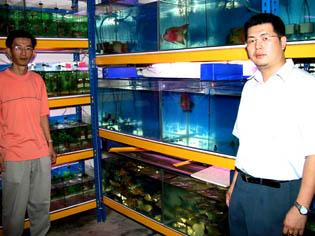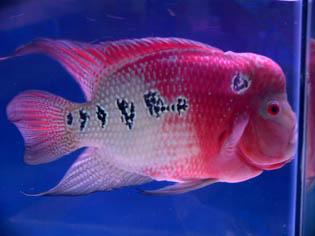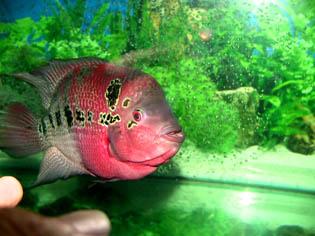|
|
Hybrid Cichlids Raking in a Fortune
 |
Paul Yii
and his brother Simon with their stock of hybrid cichlids |
SIBU: A fish with a
gargoyle-like head, the product of a Frankensteinian experiment, is raking in a fortune
for aquarium fish dealers in the country.
It’s supposedly the result of crossbreeding the African cichlid with the Giant
Gourami, locally known as the “kalui”.
Among fish fanciers, it’s known as the Hua Luo Han or the Flower Horn fish.
While its African parentage is widely claimed, some fanciers say it’s a hybrid of
several species from South America and Taiwan. But judging by its body chromatics, it’s
more likely to have African genes. Most of the fish species found in local aquariums
closely resemble African cichlids which are found in abundance in Lake Malawi, Lake
Victoria and Lake Tanganyika in Africa.
What explains the protruding forehead? The Giant Gouramis of Sabah, which apparently have
been crossbred with the cichlids. Since the hybrid has more features of the African
cichlid, it’s more accurate to refer to it as a hybrid cichlid rather than a gourami.
Among Chinese traditionalists, a protruding forehead is linked with the bearer of good
fortunes. No wonder the fish has become so popular among those who swear by the dictates
of feng shui.
Demand for the fish is skyrocketing; prices have reached dizzying heights. The more
pronounced the bulge on the forehead, the costlier it becomes. Superstitious fanciers say
the bulge symbolises good feng shui. It’s a surefire way to usher prosperity your
way, they swear. But be prepared for near-insolvency. One fine specimen with the
bulging forehead could set you back by as much as between RM10,000 and RM50,000.
A Singaporean businessman recently parted with S$180,000 (RM387,000) for just one Golden
Horn. The dark spots that cover the flanks resemble Chinese calligraphy; punters even
swear these resemble four-digit numbers, an that stroking the bulbous head improves their
chances of striking it big at the next lottery draw. That explains that overpoweringly
fishy smell that’s been wafting around four-digit lottery outlets in recent weeks.
For those who are put off by the grotesque, gargoyle-like head, gape at the dorsal fin
instead. The movements are exquisite, exuding regality.
On the average, the hybrid cichlid grows to a length of about 30 cm. It has an average
lifespan of ten years.
 |
The
bulbous head is much sought after |
Since its entry into the market in
1998, it has taken the aquarium fish industry to dizzying heights. If the 1980s belonged
to the Arowana, this new decade undoubtedly belongs to the hybrid cichlid.
Notes Paul Yii of The Mermaid World located at Belian Lane here, “This fever has
rapidly spread to the neighbouring country and gradually (it should spread) to the whole
world. Besides, it also help generate huge interest in fish rearing among locals.”
Fish rearing, Yii figures, has hitherto been viewed as just another hobby. For the
enterprising and superstitious, getting to hit the jackpot can be as easy as installing an
aquarium at a strategic location, with several fishes, including one that’s totally
black. Feng shui masters figure the black specimen is a protection against ill fortune.
Whether or not it actually works is debatable, but such superstition is taking root even
among the highly-educated, including non-Asians. Little wonder that the hybrid cichlid is
going places.
Now for a few non-feng shui pointers. Generally, an aquarium should not be placed at too
low a level since it would be difficult to detect leakages. A dank and damp environment at
home isn’t conducive for health either. Moreover, placing the aquarium at a higher
level prevents accidents, especially when there are lively children in the house.
Yii says it’s also best to avoid locations like beneath the altar, facing the kitchen
and in a bedroom, since these are considered inauspicious.
Adds Yii, “People these days are more conscious about feng shui and most have their
way of looking after their aquariums.”
He has been trading in the colourful cichlids for only eight months, and he notices the
huge impact on local fish fanciers.
Says he, “It’s getting better and people, from all walks of life, are showing
interest in rearing fish. This augurs well for the hobby.”
Most fanciers make do with the basic aquarium for tropical fish. Explains Yii,
“Comparatively speaking, tropical fish are much easier to rear. All the fish rearers
need to do is to feed the fish and they will grow.”
The rearing of marine fish, which is highly popular in Singapore, is not not popular here
because of the expertise needed to keep a flourishing aquarium. Moreover, more equipment
are needed, including a water filtering system. It’s a niche market, and few are
adventurous enough to give it a go.
Compared with the hybrid cichlid and arowana, marine fish are cheaper. Some of the more
familiar varieties include the damsel, tang, trigger, butterfly fish and a mind-boggling
variety of angelfish, all available for between RM10 and RM20 each. However, some rare
species of angelfish could cost as much as RM600 each.
Notes Yii, “The problem, of course, is the high rate of mortality. That’s why
few people dare to rear marine fish.”
If you fancy having a marine aquarium, take note of Yii’s tips. Always ensure that
the water and filtration system are clean.
Water in an aquarium easily becomes polluted. Waste products contain nitrogenous and
organic matter which will eventually poison the aquarium. Speeding up this process is
rotting fish feed leftovers. The toxicity of the water weakens resistance to dieases. Poor
appetite also results. Hence, it’s essential to have a sophisticated filtration
system. An effective filtration system generates oxygen while expelling toxic gases and
removing waste products.
According to Yii, the water needs to changed at least once a fortnight. This is to remove
the accumulated ammonia and the fish droppings.
 |
If it
doesn't bulge, neither would your wallet |
He advises, “If you cannot
provide a nice and appropriate home for the fish, how could the fish unfold its charmness
and beauty before your eyes?”
Generally, fish are fed three times a day. With meticulous care. marine fish can survive
for two to three years. Freshwater fish, on the other hand, can survive for 10 to 12
years. Notably, marine fish do not undergo growth spurts and usually maintain their vivid
colours.
The Mermaid World also deals in a
huge variety of shrimps for the aquarium. Also available is a large variety of local
freshwater fish and plants.
Yii is aiming high. He hopes to export some of the tropical fish to Indonesia.
Source: Borneo
Post
BACK
TO LEISURE PAGE
|
